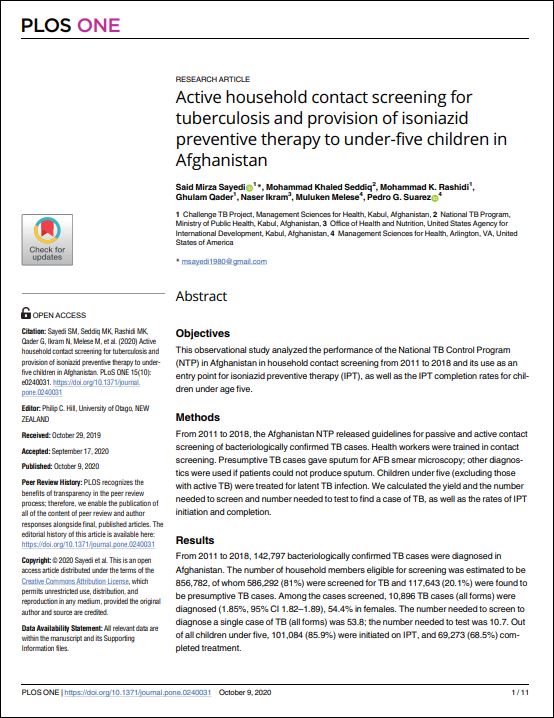Active household contact screening for tuberculosis and provision of isoniazid preventative therapy to under-five children in Afghanistan

Citation: Sayedi SM, Seddiq MK, Rashidi MK, Qader G, Ikram N, Melese M, et al. (2020) Active household contact screening for tuberculosis and provision of isoniazid preventive therapy to under-five children in Afghanistan. PLoS ONE 15(10): e0240031. https://doi.org/10.1371/journal.pone.0240031
Abstract: Objectives
This observational study analyzed the performance of the National TB Control Program (NTP) in Afghanistan in household contact screening from 2011 to 2018 and its use as an entry point for isoniazid preventive therapy (IPT), as well as the IPT completion rates for children under age five.
Methods
From 2011 to 2018, the Afghanistan NTP released guidelines for passive and active contact screening of bacteriologically confirmed TB cases. Health workers were trained in contact screening. Presumptive TB cases gave sputum for AFB smear microscopy; other diagnostics were used if patients could not produce sputum. Children under five (excluding those with active TB) were treated for latent TB infection. We calculated the yield and the number needed to screen and number needed to test to find a case of TB, as well as the rates of IPT initiation and completion.
Results
From 2011 to 2018, 142,797 bacteriologically confirmed TB cases were diagnosed in Afghanistan. The number of household members eligible for screening was estimated to be 856,782, of whom 586,292 (81%) were screened for TB and 117,643 (20.1%) were found to be presumptive TB cases. Among the cases screened, 10,896 TB cases (all forms) were diagnosed (1.85%, 95% CI 1.82–1.89), 54.4% in females. The number needed to screen to diagnose a single case of TB (all forms) was 53.8; the number needed to test was 10.7. Out of all children under five, 101,084 (85.9%) were initiated on IPT, and 69,273 (68.5%) completed treatment.
Conclusions
Program performance in contact screening in Afghanistan is high, at 81%, and the yield of TB is also high—close to 10 times higher than the national TB incidence rate. IPT initiation and completion rates are also high as compared to those of many other countries but need further improvement, especially for completion.
This observational study analyzed the performance of the National TB Control Program (NTP) in Afghanistan in household contact screening from 2011 to 2018 and its use as an entry point for isoniazid preventive therapy (IPT), as well as the IPT completion rates for children under age five.
Methods
From 2011 to 2018, the Afghanistan NTP released guidelines for passive and active contact screening of bacteriologically confirmed TB cases. Health workers were trained in contact screening. Presumptive TB cases gave sputum for AFB smear microscopy; other diagnostics were used if patients could not produce sputum. Children under five (excluding those with active TB) were treated for latent TB infection. We calculated the yield and the number needed to screen and number needed to test to find a case of TB, as well as the rates of IPT initiation and completion.
Results
From 2011 to 2018, 142,797 bacteriologically confirmed TB cases were diagnosed in Afghanistan. The number of household members eligible for screening was estimated to be 856,782, of whom 586,292 (81%) were screened for TB and 117,643 (20.1%) were found to be presumptive TB cases. Among the cases screened, 10,896 TB cases (all forms) were diagnosed (1.85%, 95% CI 1.82–1.89), 54.4% in females. The number needed to screen to diagnose a single case of TB (all forms) was 53.8; the number needed to test was 10.7. Out of all children under five, 101,084 (85.9%) were initiated on IPT, and 69,273 (68.5%) completed treatment.
Conclusions
Program performance in contact screening in Afghanistan is high, at 81%, and the yield of TB is also high—close to 10 times higher than the national TB incidence rate. IPT initiation and completion rates are also high as compared to those of many other countries but need further improvement, especially for completion.
Author(s): Said Mirza Sayedi, Mohammad Khaled Seddiq, Mohammad K. Rashidi, Ghulam Qader, Naser Ikram, Muluken Melese, Pedro G. Suarez
Year: 2019
Language: English
Region(s): AFGHANISTAN
Resource Type: Journal Articles
Source: Other
